 Walt Disney released SNOW WHITE AND THE SEVEN DWARFS a couple years after Dante Barbetta was born. Dante’s parents had emigrated to New York from Italy. His father was a pastry chef in Manhattan’s elegant Pierre Hotel.
Walt Disney released SNOW WHITE AND THE SEVEN DWARFS a couple years after Dante Barbetta was born. Dante’s parents had emigrated to New York from Italy. His father was a pastry chef in Manhattan’s elegant Pierre Hotel.
 Through the tail end of the Great Depression and the rationing of World War Two, Dante grew up at 103-105 Havemeyer Street, a culturally diverse Brooklyn apartment building. Yet, Dante never wanted for much. Give the kid a pencil and something to draw on, he was content. Disney cartoons fascinated him. Around 1941, when Dante was six, TIME Magazine did a story about DUMBO, focusing on animator Bill Tytla. Dante got Preston Blair’s how-to book about animation, learning the basics. You know what!?! Young Dante Barbetta did want something . . . he wanted to meet Bill Tytla and Preston Blair, and he wanted to be a professional animator!
Through the tail end of the Great Depression and the rationing of World War Two, Dante grew up at 103-105 Havemeyer Street, a culturally diverse Brooklyn apartment building. Yet, Dante never wanted for much. Give the kid a pencil and something to draw on, he was content. Disney cartoons fascinated him. Around 1941, when Dante was six, TIME Magazine did a story about DUMBO, focusing on animator Bill Tytla. Dante got Preston Blair’s how-to book about animation, learning the basics. You know what!?! Young Dante Barbetta did want something . . . he wanted to meet Bill Tytla and Preston Blair, and he wanted to be a professional animator!
 Dante Barbetta went into training. He tackled art with the endurance of an Olympic runner. Dante’s little brother Victor was often by his side. Building a portfolio, mostly inspired by the Disney style, secured Dante’s enrollment in the High School of Industrial Arts on East 79th Street, four blocks from Central Park and the Museum of Modern Art. In 1951, at age 16, he won the NY Journal-American’s city-wide coloring contest promoting Disney’s latest movie ALICE IN WONDERLAND. The High School of Industrial Arts is where Dante Barbetta met Pablo Ferro.
Dante Barbetta went into training. He tackled art with the endurance of an Olympic runner. Dante’s little brother Victor was often by his side. Building a portfolio, mostly inspired by the Disney style, secured Dante’s enrollment in the High School of Industrial Arts on East 79th Street, four blocks from Central Park and the Museum of Modern Art. In 1951, at age 16, he won the NY Journal-American’s city-wide coloring contest promoting Disney’s latest movie ALICE IN WONDERLAND. The High School of Industrial Arts is where Dante Barbetta met Pablo Ferro.
In many ways they were opposites. Pablo – head-strong and wild. Dante – sedate and straight=laced. They met respectfully, as serious artists. The worst Pablo was able to corrupt Dante was to convince him to ditch school one nice spring day.

In fact, Dante corrupted Pablo, infecting him with the animation bug. Pablo’s friend Phil Kimmelman soon became the third Mouseketeer. That storefront studio in Brooklyn happened, fueled by meals in Dante’s Mom’s kitchen. But Dante’s Dad was too ill to work. Dante was forced to drop out of school and take a job. That portfolio of his got Dante a position designing screen prints. He fell in love with a coworker, a charming Italian girl named Mary. They married right-off. Pablo was best man. Dante and Mary took a small apartment in Brooklyn.
 Dante showed his portfolio around the growing number of animation shops in Manhattan. He met Bill Tytla while interviewing at Tempo Productions. Yada-yada-yada, Dante was inking at Famous Studios beside Phil Kimmelman. The two of them made up a goofy song about ‘going to see a Popeye cartoon’ that they sang every time their department was brought to the screening room to watch a completed film. Nellie Sanborn, their supervisor, liked the two boys. Dante occasionally stayed a bit late to talk with her about the old days when Famous had been Fleisher Studios.
Dante showed his portfolio around the growing number of animation shops in Manhattan. He met Bill Tytla while interviewing at Tempo Productions. Yada-yada-yada, Dante was inking at Famous Studios beside Phil Kimmelman. The two of them made up a goofy song about ‘going to see a Popeye cartoon’ that they sang every time their department was brought to the screening room to watch a completed film. Nellie Sanborn, their supervisor, liked the two boys. Dante occasionally stayed a bit late to talk with her about the old days when Famous had been Fleisher Studios.
After a few months Dante and Phil traded in their pens for pencils as part of Ruth Platt’s inbetweening department. Dante was a gifted mimic, and Phil tried convincing him to audition as a voice actor. Dante refused. He was right where he belonged, at an animation desk with a pencil in his hand. Now he could sit in a theater with his family, point to the screen, and say “I worked on that”.
 Dante’s kid brother got a job at Famous Studios in 1955, just about the time Phil Kimmelman departed to do television commercials at Chad Associates. Pablo Ferro rose quickly at Tempo Productions. But it was slower going at a large shop like Famous, with a corporation scrutinizing every facet. Guys in suits marked their territory by changing Famous Studios’ name to Paramount Cartoons in 1956. Celebrated animator Al Eugster noticed Dante’s skills and bumped him up to assistant animator.
Dante’s kid brother got a job at Famous Studios in 1955, just about the time Phil Kimmelman departed to do television commercials at Chad Associates. Pablo Ferro rose quickly at Tempo Productions. But it was slower going at a large shop like Famous, with a corporation scrutinizing every facet. Guys in suits marked their territory by changing Famous Studios’ name to Paramount Cartoons in 1956. Celebrated animator Al Eugster noticed Dante’s skills and bumped him up to assistant animator.
The two amiable personalities meshed well and Dante became a valued member of Eugster’s unit. So much so that their 1957 cartoon about a boy battling an imaginary dragon was titled DANTE DREAMER.

Dante Barbetta had achieved his dream, indeed. He and Mary were trying to start a family. Victor was inbetweening in the same studio. Dante’s two best friends were animating nearby. He was earning full animator’s scale at a steady job. Unexpectedly, management called Dante to the office and explained that due to mass lay-offs they were terminating his employment!

It was no reflection on him. Paramount axed some of its best people. Al Eugster ended up at Gifford Animation, a relatively new studio that already had Pablo Ferro and Phil Kimmelman.
Dante, Phil, Pablo, the three of them were in the thick of the animation scene, part of a new generation.
Film Graphics hired Dante. That studio was run by Lee Blair, another old Disney hand. Film Graphics animation supervisor Don Towsley guided his charges in a methodical Disneyesque style. Dante fit right in. His personal drawings were Disney inspired marker pieces done on cardboard. A humble artist with visions of grandeur.

And his boss Lee Blair’s brother was the inimitable Preston Blair, who stopped in all the time with overflow work from his own studio in Connecticut. Victor Barbetta resigned from Paramount Cartoons for a desk at Film Graphics. Preston Blair took a liking to Dante. Preston hired Dante to do some work in Westport. It was a long commute. They worked late. Preston drove Dante to the railway station. The last train home pulled out just as they arrived. That’s when Preston Blair stomped on the gas pedal like a manic wolf in some Tex Avery cartoon. They beat the train to the next station.
Complications from diabetes hospitalized Victor in the summer of 1957. He returned to work about a month later. Employment at the small studios such as Film Graphics ran hot and cold. Many shops also did live-action industrial films and TV commercials, perhaps using bits of limited animation. Cartoon teleblurbs were popular enough to keep a fellow busy if he could follow the work from studio to studio. Dante spent a good deal of time knocking on doors. Though classified as a full-tilt animator, Dante accepted any assignment that kept the bills paid: inking, inbetweening, assistant animating.
The U.S. Army inducted Dante at the start of 1958, then honorably discharged him two months later. He continued freelancing, ending up at Shamus Culhane Productions in June. Shamus Culhane was another guy Dante had always wanted to meet. Culhane and Al Eugster were good friends, having worked together for Fleischer, Iwerks, and Disney. Eugster was currently at Gifford Animation alongside Phil Kimmelman.
Dante didn’t stick around long enough to meet Shamus Culhane because the shop supervisor came off too brash. It was back to freelancing. He once dropped in at Storyboard. The place was empty except for one guy minding the store who flipped through Dante’s portfolio. Only later did Dante learn he’d been face-to-face with the legendary John Hubley.
Paramount Cartoons called Dante in to design characters for a couple of Noveltoons, GOODIE THE GREMLIN being one.

It was a somewhat bittersweet chance to get back on theater screens. The level of sophistication in the animation sought by Paramount was a far-cry below what Dante had imagined he’d be doing. The magical Disney and Fleischer stuff Dante grew up on just wasn’t being made anymore. Budgetary restraints limited all aspects of theatrical cartoon production. Dante Barbetta had been born a couple decades too late for animation’s golden age.
He and Mary decided to adopt, first a boy, then a girl. Mary managed to squirrel away enough for a down payment on a house in Flushing, Queens.
 In the summer of 1962 Dante joined Joe Oriolo’s new studio Adventure Cartoons for Television at 136 West 32nd Street. A number of veterans from the golden age were there doing THE MIGHTY HERCULES. John Gentilella and Dante reconnected. Johnny Gent, as his peers called him, was pure animator. He’d been president of the union local six times.
In the summer of 1962 Dante joined Joe Oriolo’s new studio Adventure Cartoons for Television at 136 West 32nd Street. A number of veterans from the golden age were there doing THE MIGHTY HERCULES. John Gentilella and Dante reconnected. Johnny Gent, as his peers called him, was pure animator. He’d been president of the union local six times.
Gentilella’s career started in New York during the early 30s at Van Beuren Studios. He sojourned to Hollywood for a stint with Walter Lantz, but returned home for a desk at Terrytoons. Paul Terry gave Johnny Gent the old heave=ho during 1944 due to involvement with the union. Famous Studios picked him up, and that’s where Gentilella first met Barbetta.
THE MIGHTY HERCULES finished production in 1964. Before long Dante found himself back at Paramount Cartoons, where there was no overtime available. At least Seymour Kneitel was an easy-going supervisor. That changed. Kneitel and studio manager Abe Goodman called Dante to the office, insisting he turn out pages faster. Did they think he was slouching off? He explained that what they wanted just wasn’t possible.
Abe Goodman countered by reveling plans to build Paramount Cartoons back to greatness. Seymour Kneitel’s sudden death quashed those plans. The next supervisor turned out to be a disaster. Paramount’s executives did something smart in 1966, they put Shamus Culhane in charge of their cartoons. Al Eugster returned. Fresh possibilities emerged.
 Culhane immediately deduced Dante’s skills were not being utilized to full potential. He sent Dante to an advanced design class. THINK OR SINK, the only Paramount cartoon to be shown at the international animation festival in Annecy, France, featured character designs and layouts by Dante Barbetta. Culhane’s autobiography TALKING ANIMALS AMD OTHER PEOPLE includes examples of Dante’s work.
Culhane immediately deduced Dante’s skills were not being utilized to full potential. He sent Dante to an advanced design class. THINK OR SINK, the only Paramount cartoon to be shown at the international animation festival in Annecy, France, featured character designs and layouts by Dante Barbetta. Culhane’s autobiography TALKING ANIMALS AMD OTHER PEOPLE includes examples of Dante’s work.
The bulk of the work being done at Paramount involved a television show about Marvel Comics’ THE MIGHTY THOR. Dante worked on them, and if he got called into Culhane’s office it was to discuss the next theatrical cartoon with Al Eugster, or to listen to Culhane’s stories about the glory days at Disney.
Culhane put Paramount Cartoons back on track and detailed his plans to build an East Coast studio that would rival Disney, but corporate execs had already decided to downsize. Some equipment was broken up and put out for trash. Everybody moved over to Paramount’s recording studio at 331 West 44th Street. Shamus Culhane resigned in disgust. Ralph Bakshi was brought in to replace him. A counter-culture GO GO TOONS series lacking any imagination reduced Dante to little more than an inbetweener.
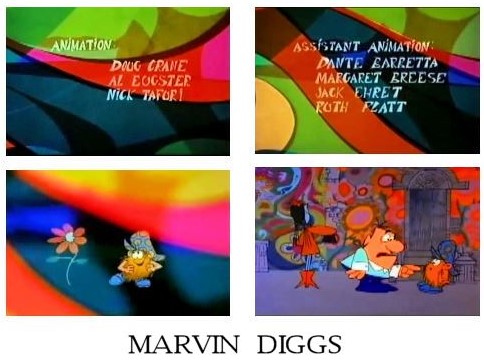
Dante’s take on Ralph Bakshi is that he’s a talented guy, but not everybody should be put in charge of a studio. Anyways, Paramount Cartoons closed in 1967. By year’s end Dante and Victor were car-pooling with Johnny Gent over the George Washington Bridge to Bill Ackerman’s studio in Midland Park, New Jersey.
Bill Ackerman had been at Paramount on THE MIGHTY THOR, and with Hal Seeger Productions, and Terrytoons before that. He really admired the old Disney style, but the commercial work he was doing didn’t allow for it. Ackerman Studios soon folded and it was back to freelancing for the lot of them.
 Dante settled in for a short while at designer Ray Favata’s Gryphon Studios. Dante and Paul Sparagano were the two animators at Gryphon and got on well. Sparagano, a talented jazz musician, had been around a bit longer than Dante, with time in at Film-Art and Film Graphics.
Dante settled in for a short while at designer Ray Favata’s Gryphon Studios. Dante and Paul Sparagano were the two animators at Gryphon and got on well. Sparagano, a talented jazz musician, had been around a bit longer than Dante, with time in at Film-Art and Film Graphics.
Victor got in at Focus Designs in 1968, where Phil Kimmelman was in charge. Dante followed in 1969, just as the Public Broadcasting System instituted the Children’s Television Workshop. The concept of ‘edutainment’ opened new avenues for animation to explore. Famed animation director Chuck Jones produced a show called CURIOSITY SHOP. Phil had Dante and Victor do a short segment for Jones where a sea captain loads the numbers 1 through 20 into a boat. Harvey Kurtzman from MAD Magazine designed the spot. Note that the numbers actually grow larger in size as they get higher. The synchronization matching the character’s mouth movement to the dialogue is impeccable.

Dante and Victor had Michael Sporn inbetwwening for them at Focus. Both brothers agreed Sporn was a nice guy, but they doubted he had what it took to make it as an animator.
Riding the edutainment wave, in 1972 Phil opened his own studio, primarily to produce the new series known as SCHOOLHOUSE ROCK. The Barbetta brothers were at Phil Kimmelman & Associates to help with a bunch of them. Phil Kimmelman and Dante Barbetta had worked together, on-and-off, since high school. Twenty years. Phil trusted Dante to keep it on budget, but give it some zip. The jaunty swagger on the rabbit in LUCKY SEVEN SAMPSON is classic Barbetta.
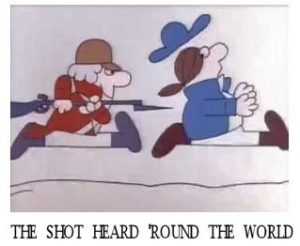 Dante worried about Victor’s diabetes, but home-life was good. Dante couldn’t be found among the bars and diners of Time Square after hours. He was in his house with Mary and the kids. No, Times Square at night belonged to Pablo Ferro, who didn’t even roll out of his Greenwich Village lost until about the hour when Dante boarded the subway homeward. Dante missed his friend’s company, his artistic feedback. They had drifted out of touch. Phil still saw Pablo around, when Pablo was in town, because he worked a lot in Hollywood. In fact, Pablo Ferro had become a big deal in the industry.
Dante worried about Victor’s diabetes, but home-life was good. Dante couldn’t be found among the bars and diners of Time Square after hours. He was in his house with Mary and the kids. No, Times Square at night belonged to Pablo Ferro, who didn’t even roll out of his Greenwich Village lost until about the hour when Dante boarded the subway homeward. Dante missed his friend’s company, his artistic feedback. They had drifted out of touch. Phil still saw Pablo around, when Pablo was in town, because he worked a lot in Hollywood. In fact, Pablo Ferro had become a big deal in the industry.
Two decades earlier Dante and Pablo first experienced FANTASIA in a Brooklyn theater together. They talked about someday meeting the people who made that wondrous piece of drawing in motion: Bill Tytla; Preston Blair; John Hubley; Al Eugster . . . Now Dante and Pablo were both well respected enough to be invited to sit at the table with any of those folk. Dante still socialized with Al Eugster, who was currently at Kim-Gifford Productions. It happened to be that Phil sent overflow work from SCHOOLHOUSE ROCK to Kim-Gifford, so Barbetta and Eugster were back to sharing screen credits.
An opportunity to spend six months working on a feature-length animated film alongside Victor popped up. Better yet – Johnny Gent was supervising. Bill Ackerman was there, and Roger Mejia, and Bill Hudson, and Paul Sparagano, whose daughter Diane was inking. A bunch of New York’s best people were on the project, under the less than capable direction of Sam Singer.
TUBBY THE TUBA was made at the New York Institute of Technology in Old Westbury, Long Island, financed by millionaire Alexander Schure, a founder of the school. NYIT’s mission was to bridge the divide between developing technology and the liberal arts. Their Computer Graphics Lab opened in 1974. TUBBY THE TUBA served two purposes. One was for Ed Catmull’s team of software engineers to observe what animators actually do and convert that to programming. Later, the completed movie could be released and earn money to finance more research.

The first part went well, but TUBBY THE TUBA flopped at the box office. Okay, so it has elephants dancing in tutus, but FANTASIA it ain’t! They worked under adverse conditions, lacking much equipment as a studio was built around them. Animators waited for construction guys to empty wooden crates so they would have something to sit on. There are nice flourishes of animation throughout TUBBY THE TUBA, and a decent soundtrack.
Ed Catmull’s software development team pressed forward. Dante and Victor’s contracts were extended. Experimental animation was done, but never released. The whole situation confused the animators, but the checks were steady. NYIT was less than twenty miles from Dante’s house. They threw a big Christmas party every year, with all sorts of food. When diabetes weakened Victor’s eyesight, Alexander Schure kept him on the payroll. Victor passed away in 1979.
By 1984 computer animation was inevitable. Ed Catmull already had Pixar started up. Dante noted the NYIT Christmas party that year only offered sandwiches. He’d been with NYIT fourteen years, now it was back to freelancing in Manhattan. Between 1991 and 1993 Dante worked on six half-hour television specials at Michael Sporn Animation. His old inbetweener had turned out to be a really good director. Sporn was adapting children’s books for PBS. Effort was made to keep the look and feel of each original book. Dante enjoyed the experience.

By 1994 the business was nearly unrecognizable. The computer=generated animation Dante had helped usher in, but didn’t understand, consumed a good many jobs. It was at this time that Dante finally worked for Disney, not as an animator, but designing ways to place characters on clothing and other merchandise for the Disney Store. When Disney relocated that operation to California, Dante took on similar duties for the Warner Brothers Store, which also soon moved its offices to the west coast.
Dante took a job as assistant to Marvel Comics artist Jeff Aclin and his wife Angie. When the Aclins retired a couple years later Mary and Dante decided it was time for him to do the same. Not that he planned to stop animating, because as the title of this article clearly indicates – Dante Barbetta was born to animate!
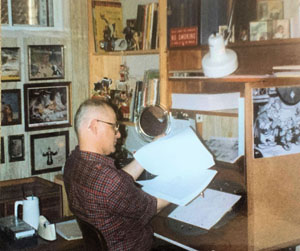 At his home studio Dante turned out new pages. Over the years many situations had arisen where his instincts told him to do a scene one way, but the client or director insisted it be done another. Now he was free to untangle those bits that had been cluttering up the back of his mind. Popeye and other characters from his days at Famous Studios flowed from Dante’s pencil. Disney character got the treatment as well, not for monetary profit, but for pure love of the art form. Sometimes he was able to get an old friend with an animation camera to photograph what he’d completed.
At his home studio Dante turned out new pages. Over the years many situations had arisen where his instincts told him to do a scene one way, but the client or director insisted it be done another. Now he was free to untangle those bits that had been cluttering up the back of his mind. Popeye and other characters from his days at Famous Studios flowed from Dante’s pencil. Disney character got the treatment as well, not for monetary profit, but for pure love of the art form. Sometimes he was able to get an old friend with an animation camera to photograph what he’d completed.

Dante kept in touch with a few of the old crew, who might drop by his home studio from time-to-time. And there was the occasional film historian reaching out, curious about the era when hand-drawn cel animation prevailed.

Dante Barbetta finally reconnected with Pablo Ferro after decades apart. Pablo lived in Hollywood, so they talked by phone. What a journey it had been for both of them. So many years, so many miles, so many drawings. Pablo mailed Dante the caricature of the two of them done in 1952, and there’s an interesting twist to that.
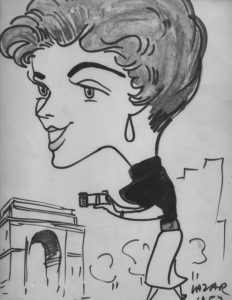 Phil Kimmelman was helping me to figure out what artist drew that piece. Dante didn’t remember, and Pablo was gone. I asked Phil to find his high school yearbook and search for clues. Instead, Phil found a 1953 caricature of his wife Dotty done by the same artist, Lazar Krstich. With help from Dave Hornish we established that Lazar Kristch was born in Serbia during 1909. He navigated the treacherous days of World War Two by sketching nightclub patrons in Vienna. The displaced persons act brought him to America. The sketch of Dotty was obviously done in Washington Square Park. My guess is that the sketch of Dante and Pablo was done in the vicinity of the Museum of Modern Art.
Phil Kimmelman was helping me to figure out what artist drew that piece. Dante didn’t remember, and Pablo was gone. I asked Phil to find his high school yearbook and search for clues. Instead, Phil found a 1953 caricature of his wife Dotty done by the same artist, Lazar Krstich. With help from Dave Hornish we established that Lazar Kristch was born in Serbia during 1909. He navigated the treacherous days of World War Two by sketching nightclub patrons in Vienna. The displaced persons act brought him to America. The sketch of Dotty was obviously done in Washington Square Park. My guess is that the sketch of Dante and Pablo was done in the vicinity of the Museum of Modern Art.
Lazar Krstich died in 1978. The image he created of two young artists remains. For, as the Romans so correctly stated: “Ars longa, vita breve” – Art is long, life is short.
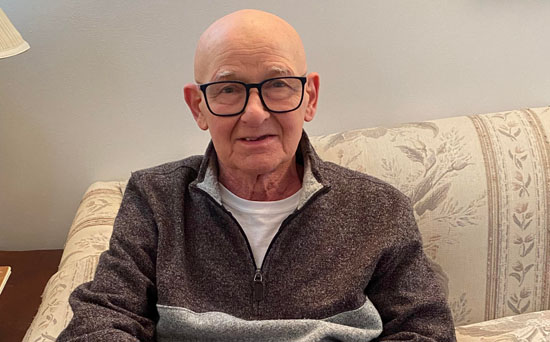
Dante Barbetta, this weekend – Photo by Devon Baxter


 BOB COAR made his way in this world as a muralist and sign painter, illustrating on just about every surface imaginable. A life-long fan of animation, he is currently searching for digital, or actual, copies of Top Cel.
BOB COAR made his way in this world as a muralist and sign painter, illustrating on just about every surface imaginable. A life-long fan of animation, he is currently searching for digital, or actual, copies of Top Cel. 









































Unlike so many other New York animators, Dante Barbetta never pursued opportunities on the West Coast or went into business for himself. Perhaps the fact that he married so young accounts for his reluctance to make such risky ventures.
As for “Tubby the Tuba”: blame Sam Singer all you want, but making a feature-length film out of a ten-minute children’s record is bound to be a bad idea no matter who’s directing it.
Wonderful article.
I had no idea there was anyone left!
It’s debatable whether Shamus Culhane’s assumption of Paramount’s cartoon studio (which he still calls Famous in his memoirs) was such a lucky break. His managerial and interpersonal skills didn’t seem to match his talent at the drawing board, but it’s doubtful anyone could have salvaged the former Fleischer/Famous at a time when the studios were disbanding their animation units.
Honestly, I thought Culhane did a good job running the studio. I thought the outpost was mostly better than some of the past studio shorts.
Actually, the Kurtzman animation spot with the sea captain was for “Sesame Street” not for “The Curiosity Shop”.
That’s right. Look it up on MuppetWiki.
Great story . I remember Danta from paramount studio in Manhattan. I started out as a inker and then into illustration. I wish Danta all the best a great animator
Bob – Awesome article. I tried to email you, but the email just bounces.
I read the piece you did called “Born to Animate” and wanted to reach out since it seems you may have some history or contacts. I have been searching for an animated film that Bill Ackerman was involved with. Seems it was a passion project of his with a lot of hope of it being picked up for more. The film series was called “The Wizard of Us” and from an article I found it seemed like there were many episodes in the series planned, but I can only confirm that one was released. It was called “A Creature of Habit”. This was marketed directly through television ads as far as I can tell, as no other information has surfaced on procuring the film. I will link you to a reddit post I had started with the hopes of getting ahold of Mr. Ackerman for more information, or perhaps to get a copy of the film. Per the television ad it was a 30 minute Edutainment film about the harmful effects of Cocaine. I only stumbled upon this film on an old VHS I was uploading to Youtube and it sounded interesting and had that classic animation style and very recognizable voice acting. I figured it would be somewhere to watch and it was nowhere to be found. I have had an ebay saved search and alert alongside others on countless other sites and the only item that has ever emerged was a T-Shirt from the promotional materials.
Anyway, sorry this is so long. I just saw that piece and Bill’s name mentioned a few times and I figured I would take a stab in the dark to revive this searched. Its becoming a nagging thing in the back of my mind at times and I’m always trying to uncover more. If you have any information on how to talk to Bill or if someone else who worked on the project in the U.R.U. company he created that would be awesome. I had located original documents of incorporation, but seems I lost that link as there were other names listed as officers, etc.
The Website I listed with my name links to the reddit thread where I have gathered information, posted the original ad I found, and looked for help.
https://www.reddit.com/r/lostmedia/comments/w3ac2k/fully_lost_wizard_of_us_or_a_creature_of_habit/
Anyone with any info, happy to have any help! I want to see this film! 🙂